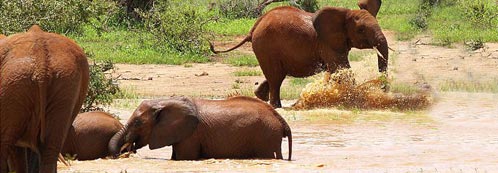Field Notes
January - April 2016
Between January and March there were record high temperatures in Tsavo with many days as high as 400C. We had several heavy rain storms during January and February. Combined with the rain in November and December from last year many of the waterholes in the bull area were small lakes. But there was little or no rain in the bull area in March, so some waterholes were dry.
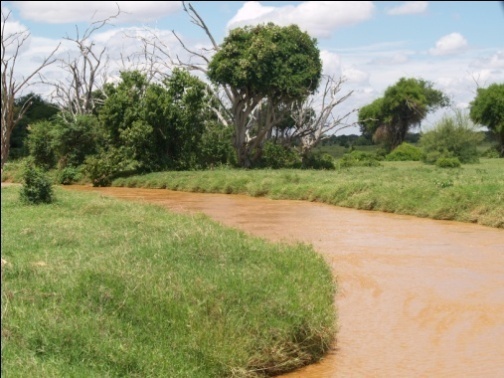
But in April the rains stared again with lightning and thunder. The seasonal Voi River, which originates outside the park in the Taita Hills, flows from west to east through the center of the park. In April the rains were quite heavy in the hills and there were waves in the river (photo left). Many bulls and families aggregate near Voi River during the rains. This year they aggregated in groups of 100 individuals on both sides of the river.
Most of the migratory birds (Barn Swallows, Eurasian Rollers, and Harriers) left Tsavo in mid-March. The few that stayed had an abundance of insects to feed on with the rains in April.
Kenya Burns Ivory & Rhino Horns — on the 30th of April in Nairobi National Park, Kenya destroyed 105 tons of elephant tusks and 1.35 tons of rhino horns. These tusks and horns were recovered from poachers, in transit for the ivory and horn trade, from human-elephant conflict or from natural causes. This historical event was a demonstration to the world that Kenya supports a total ban on the trade of elephant tusks and rhino horns.
Bulls
With exception of a few young newly independent males most bulls left the bull area between January and April. These movements out of the bull area are most likely a response to a combination of factors, rainfall, musth, and disturbances from human activity; the construction of the high speed train that is adjacent to the bull area. With the heavy rains in the south and eastern areas of the park, many bulls moved south to the Voi River region to socialize with other elephants, or bulls that came into musth left the bull area in search of estrus females.
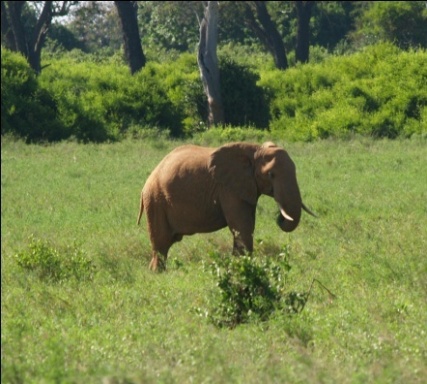
In April, Nathan, (45 years old) was alone near the Voi River. I often find him in this region during and right after the rains. He was in the early part of his musth cycle; temporal glands swollen with fluid to his jaw, standing tall and alert, with alternate ear waves. He was not aggressive, but did shake his head when I approached him. After I reversed the vehicle to give him more space, he went back to feeding.
Third (photo right) a young male of 15 years was also near Voi River with Agatha’s family of six individuals in April. He was first identified in 2014 with a group of six other newly independent males. Third spends most of his time with other young males or with a family and is rarely alone. I named him Third because he is missing one-third of his tail. I often identify an elephant by their tail features (a section missing, crooked, no hair, or few hairs) then I check tusks (one-tusk, broken or tuskless) and ears features (holes, notches, broken).
Families
Between January and April most families dispersed to their wet season range; Voi Riverine and the southern areas of the park. Families in these areas included Agatha with Third, Jezebel, Hattie, Nelly and Eldora with Skye. One-Tusker’s family and Cypris’s family (a bond group) were together in an aggregation of several families spread out in an open glade with tall grass. While I focused my binoculars on One-Tusker’s new 3-4 month old calf to determine the sex I got distracted by four young calves, all 2-3 years old, from a nearby aggregation that were in Voi River, trumpeting and trying to run against of flow of the river. When I looked back to One-Tusker’s calf, all I saw was a reddish lump in the tall grass; he/she was lying down and asleep.
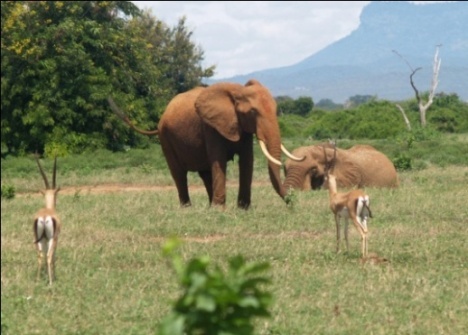
In April Primrose (photo left) was in estrus, not with her family, but with two unknown non-musth bulls; one 30 years and one 20 years, both of them had smooth ears. She stayed close to the older bull, while the younger bull watched them both. She waited for the older bull to finish drinking from the river then headed east, with the bull following, toward an aggregation of elephants in an open glade. She approached three different families, rumbled then moved on to a shady tree. The bull stayed close to her and rumbled at younger bulls that tried to approach her. After a few minutes the bull mounted her and there was a lot of trumpeting and rumbling. Then they stayed close together resting under the shade.
May - August 2016
With the heavy rains in April, many of the natural waterholes in the bull area had drinking water until mid-June.
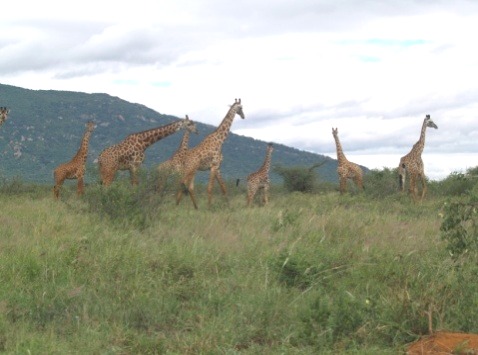
In July, the temperature dropped considerably and the winds started. In June and August, it rained for a few days, not enough to fill natural waterholes, but in some areas, the grass was green and many shrubs produced new leaves. In May, Giraffe aggregated in the bull area with several young calves. In June, the pride of lions that often spend time in the bull area were once again resting under a tree in the shade at a favored bull waterhole. One of the adult females has a distinct slit on the top of her left ear. In August, Eland aggregated with many young calves. On one occasion, several calves, just a few weeks old, were resting in the sun in the middle of the road. When I stopped to watch them, they quickly ran into the bush and a large male became alarmed and leaped across the entire width of the road. Not surprising since Eland are agile jumpers.
Bulls
Between May and June, most of the bulls in the bull area were young. They were in small groups of two-three bulls or near a family: Moonlight, Quark, Nebula and Wishbone. In May, Sandstone was alone tossing soil over his head and resting under a tree. Solar was alone 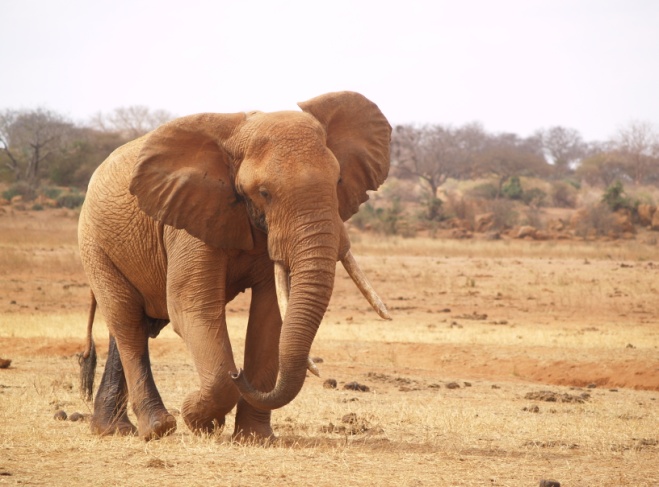 near Voi River in May and seven days later he was with two families northwest of the hills. In August, Skylight, Zero, Sunray and Sun returned to the bull area. Sunray and Sun were together in a bush-grass area feeding. Sunray decided to move to a tree to rest in the shade and Sun followed. When he got to the tree, Sunray shifted so that they were side by side resting. For the past 10-years, these two bulls have often been together.
near Voi River in May and seven days later he was with two families northwest of the hills. In August, Skylight, Zero, Sunray and Sun returned to the bull area. Sunray and Sun were together in a bush-grass area feeding. Sunray decided to move to a tree to rest in the shade and Sun followed. When he got to the tree, Sunray shifted so that they were side by side resting. For the past 10-years, these two bulls have often been together.
In July, Myron (photo left) was in musth alone traveling to a supplemental waterhole where several families were aggregating: Diamond, Miranda and Magnolia. When he joined the families, he rumbled to some females, got a drink and then headed east alone to continue his search for an estrus female. This is the first record of him in musth. He was identified 22 years ago in 1994. As a young male, between 1994 and 2005, he spent most of his time in his family’s core area, often with Darwin or near a family. I did not see him again for eight years. Then in Oct. 2014, he was near Voi River in an aggregation of bulls and families. Although his tusks had not changed very much he was considerably larger and taller since I had last seen him.
Families
Several families moved between the hills and Voi River between May and August: Primrose, Mango, Diamond, Evergreen, Olivia, Heloise, Agatha and Magnolia. Eldora and Skye were with Jade in late-May but six days later Jade was not with them. Jade is a young 15 years old 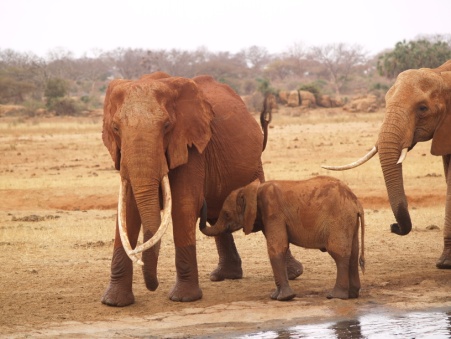 female with no offspring, who spends time with several different families. In June, July and August Savanna and Summer’s family were together in their favored dry season range at the base of the hills. Both of their offspring, born in Sept 2014 were healthy.
female with no offspring, who spends time with several different families. In June, July and August Savanna and Summer’s family were together in their favored dry season range at the base of the hills. Both of their offspring, born in Sept 2014 were healthy.
Several families also move to the base of the hills in the dry season where the shrubs and trees stay green longer than other areas. In July, Miranda (photo right) and her female offspring were with Magnolia, Diamond and several other families at a supplemental waterhole. When Myron approached her, she rumbled as he walked by. Miranda was identified 26 years ago in 1990, with two female offspring. Since 1994, she has had three female calves and one male calf. She is often alone with just her offspring and on occasion with Syna, Jasmine, Vida or Lyris.
September - December 2016
Most of the vegetation and all of the natural waterholes were dry in the bull area during September and October. There were a few localized showers in mid-November but not enough to change the habitat. When the rains started in December, the waterholes filled and the vegetation was green in the bull area. In November, several warthog families had 5-9 piglets. Migratory birds: Carmine Bee-eaters arrived in October, one was perched on a warthogs back. In November Steppe Eagles, Barn Swallows and a few Eurasian Roller arrived in the park.
The construction of the Mombasa-Nairobi elevated standard gauge railway (SGR) is nearing completion. The tracks are between Tsavo East and West National Park in the northern region and adjacent to the western park boundary of Tsavo East in the southern region. 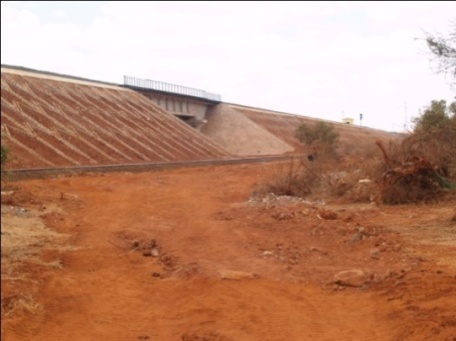 An electrical fence will be installed with openings at a few bridges (photo left) and tunnels for wildlife to move across park boundaries. Surveys in September and October were conducted to determine whether elephants used the bridges or tunnels. Based on the location of footprints and dung, many elephants walked north and south along the base of the new tracks, perhaps looking for a way to cross. At several locations, there were elephant paths (footprints) up and over the embankment; indicating some elephant climbed over the tracks rather than use a bridge or tunnel. When construction is completed and the electrical fence is powered, elephants will need to use a tunnel or bridge if they want to move across park boundaries.
An electrical fence will be installed with openings at a few bridges (photo left) and tunnels for wildlife to move across park boundaries. Surveys in September and October were conducted to determine whether elephants used the bridges or tunnels. Based on the location of footprints and dung, many elephants walked north and south along the base of the new tracks, perhaps looking for a way to cross. At several locations, there were elephant paths (footprints) up and over the embankment; indicating some elephant climbed over the tracks rather than use a bridge or tunnel. When construction is completed and the electrical fence is powered, elephants will need to use a tunnel or bridge if they want to move across park boundaries.
Bulls
Unlike previous late-dry seasons, when older bulls were in the bull area in large groups, most of the bulls in the bull area were young, in small groups or alone. Their distribution and group size may be related to resource availability or disturbances from the train construction on the western boundary of the bull area. The bulls that were in the bull area between September and early November were Skylight, Sandstone, Sunray, Solar, Jarvis, Riley, Moonlight, Crux, Pewter and Blazer.
Wishbone (photo left, bull on the right) was first photographed and named in April 2010. He is rarely alone, preferring to be with other bulls the same age (Pepper, Moonlight, and Pewter) or with a family. Sword (photo right) was identified in January 2011. He is typically in a bull group, associating with Linus, Spartacus, Knox and Paleus near Voi River. In September, he was again near Voi River but this time alone.
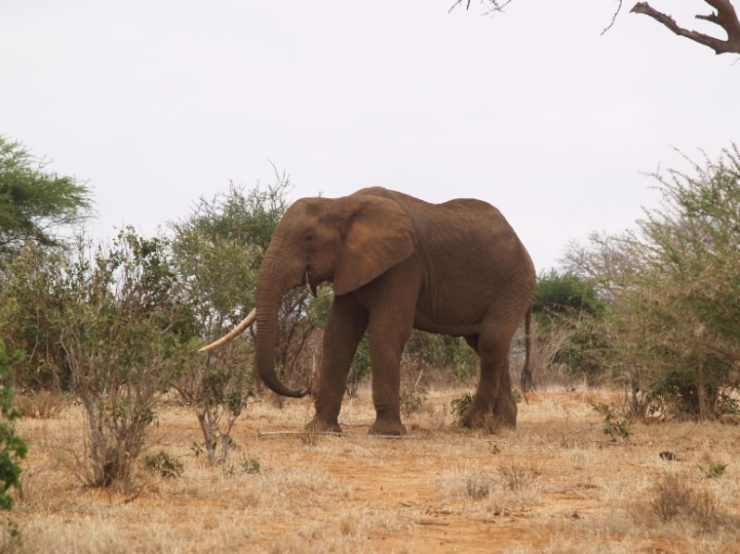
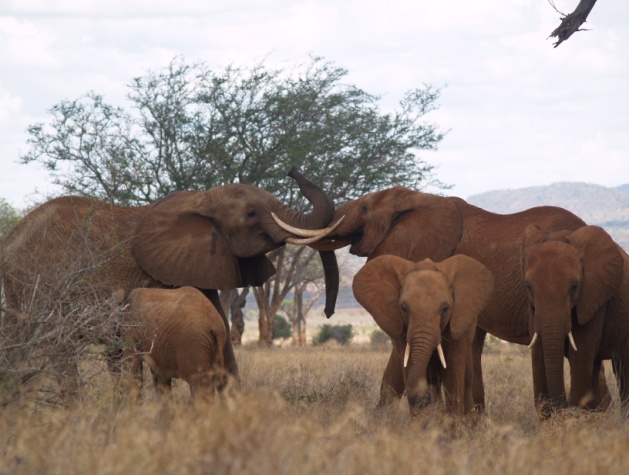
Four new bulls, with distinct features, were photographed and named. Apus was alone in the bull area. Near Voi River, Magnet was following a family, Sherlock was alone and Ganymede was with another bull.
Families
Many families aggregated near supplemental water sources between September and mid-November. Several females, identified in the 1990’s were in these aggregations: Diamond, Nola, Miranda, Cypris, Magnolia and CT. Now in their 40’s and 50’s they are matriarchs, with many years of experience. Their offspring, associating young families and young bulls learn from these matriarchs; safe areas and locations of resources.
Medora (photo left) is one of the oldest known females. I photographed and named her in July1990, with a two-year old male calf. Her offspring since 1992: one male and three females. Her last calf, a female, was born in 2011. Medora’s family is part of the Hill Clan; spending most of their time in the areas surrounding the hills. Similar to Eldora and Holda, she has a small family and is often with just her offspring. In September, she was with her three offspring, feeding, in an open grassland area.
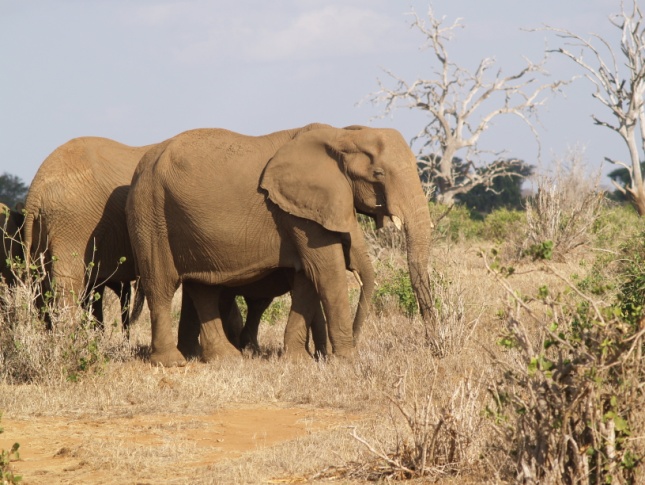
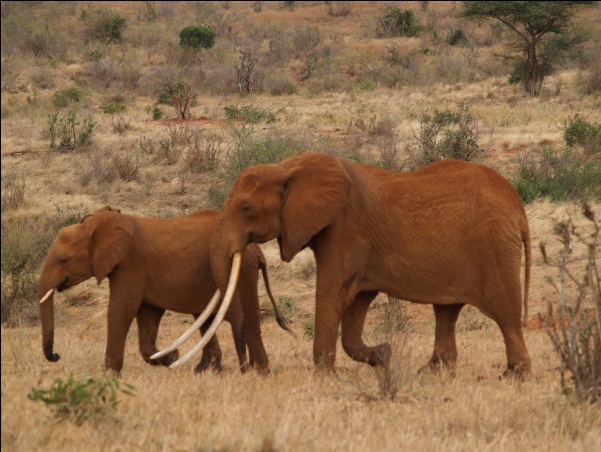
Mocha (photo right) a new female was photographed and named in July 2016, with a male two-year old calf, in a family unit of eight, near Voi River-west. In October, they were at Kanderi heading south to join an aggregation of families. In September and October five new adult females (with their offspring) were photographed and named: Chestnut and Maple were near Voi River-west, Apricot and Tulip were at Voi River-Kanderi and Almond’s family was resting under a palm tree on the bank of Mbololo River.
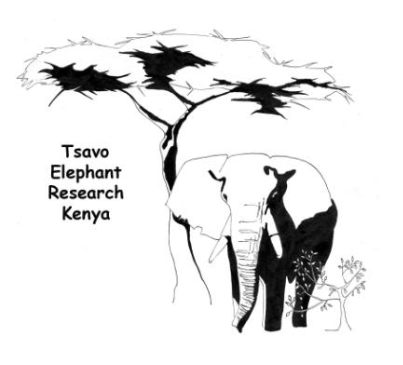
Tsavo Elephant Research Needs Your Help.
Donations are needed to continue this 30+ year field study
and support a Kenyan research field team.
We monitor the behaviors of Tsavo known bulls and families:
group dynamics, offspring & survival, musth cycles and habitat use.
Please click here or on the donate button
to send your donation.
Thank you!
Barbara
